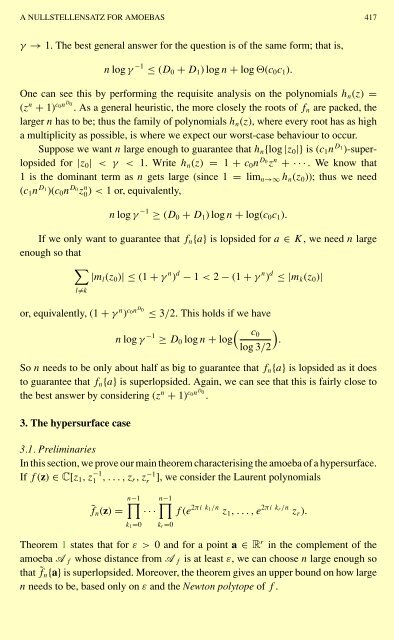A NULLSTELLENSATZ FOR AMOEBAS
A NULLSTELLENSATZ FOR AMOEBAS
A NULLSTELLENSATZ FOR AMOEBAS
You also want an ePaper? Increase the reach of your titles
YUMPU automatically turns print PDFs into web optimized ePapers that Google loves.
A <strong>NULLSTELLENSATZ</strong> <strong>FOR</strong> <strong>AMOEBAS</strong> 417<br />
γ → 1. The best general answer for the question is of the same form; that is,<br />
n log γ −1 ≤ (D 0 + D 1 ) log n + log (c 0 c 1 ).<br />
One can see this by performing the requisite analysis on the polynomials h n (z) =<br />
(z n + 1) c 0n D 0<br />
. As a general heuristic, the more closely the roots of f n are packed, the<br />
larger n has to be; thus the family of polynomials h n (z), where every root has as high<br />
a multiplicity as possible, is where we expect our worst-case behaviour to occur.<br />
Suppose we want n large enough to guarantee that h n {log |z 0 |} is (c 1 n D 1 )-superlopsided<br />
for |z 0 | < γ < 1. Write h n (z) = 1 + c 0 n D 0 zn + ···. We know that<br />
1 is the dominant term as n gets large (since 1 = lim n→∞ h n (z 0 )); thus we need<br />
(c 1 n D 1 )(c 0n D 0 zn 0 ) < 1 or, equivalently,<br />
n log γ −1 ≥ (D 0 + D 1 ) log n + log(c 0 c 1 ).<br />
If we only want to guarantee that f n {a} is lopsided for a ∈ K, we need n large<br />
enough so that<br />
∑<br />
|m l (z 0 )|≤(1 + γ n ) d − 1 < 2 − (1 + γ n ) d ≤|m k (z 0 )|<br />
l≠k<br />
or, equivalently, (1 + γ n ) c 0n D 0<br />
≤ 3/2. This holds if we have<br />
(<br />
n log γ −1 c<br />
)<br />
0<br />
≥ D 0 log n + log .<br />
log 3/2<br />
So n needs to be only about half as big to guarantee that f n {a} is lopsided as it does<br />
to guarantee that f n {a} is superlopsided. Again, we can see that this is fairly close to<br />
the best answer by considering (z n + 1) c 0n D 0<br />
.<br />
3. The hypersurface case<br />
3.1. Preliminaries<br />
In this section, we prove our main theorem characterising the amoeba of a hypersurface.<br />
If f (z) ∈ C[z 1 ,z −1<br />
1 ,...,z r,z −1 ], we consider the Laurent polynomials<br />
˜f n (z) =<br />
∏n−1<br />
k 1 =0<br />
r<br />
···<br />
∏n−1<br />
k r =0<br />
f (e 2πi k 1/n z 1 ,...,e 2πi k r /n z r ).<br />
Theorem 1 states that for ε>0 and for a point a ∈ R r in the complement of the<br />
amoeba A f whose distance from A f is at least ε, we can choose n large enough so<br />
that ˜f n {a} is superlopsided. Moreover, the theorem gives an upper bound on how large<br />
n needs to be, based only on ε and the Newton polytope of f .
















